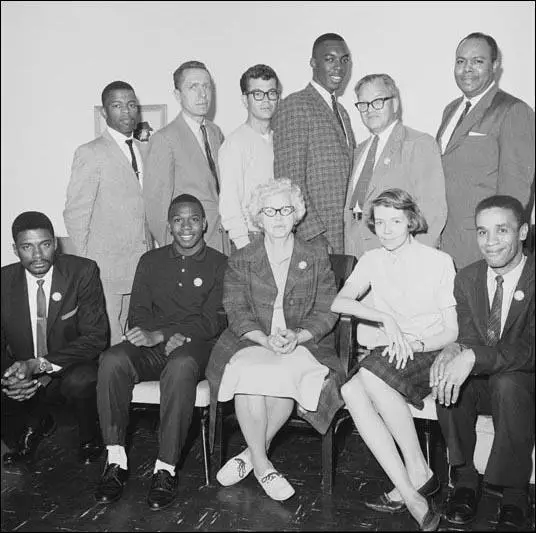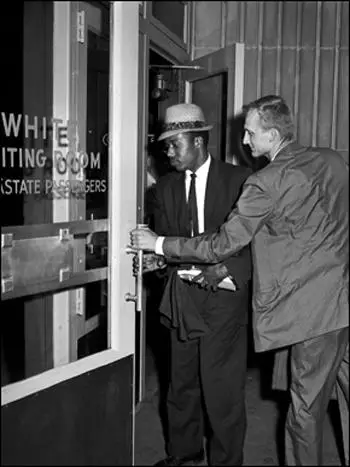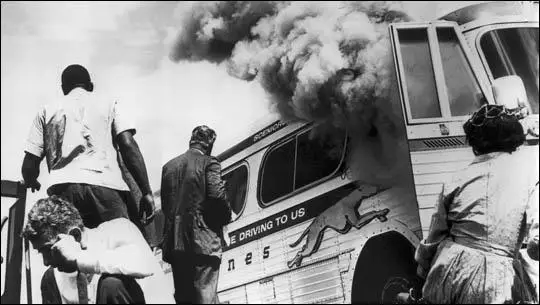John Moody
John H. Moody was born in Philadelphia in 1931. As a teenager he was a leader of the local NAACP Youth Council. While a student at Howard University and an active member of the Student Nonviolent Coordinating Committee and the affiliated Nonviolent Action Group (NAG), which had staged a series of successful sit-ins in Washington, Maryland, and northern Virginia. "Self-conscious about his Northern background, he was both fascinated and frightened by images of black life in the Jim Crow South. As a young boy in Philadelphia, he listened with rapt attention to a transplanted North Carolina-born cousin who often reminisced about violent encounters with white Southern racists." (1)
Moody explained to his parents why he had joined the Congress of Racial Equality (CORE): "This is one of the important things which I have been experiencing during the last year and what little I have done for the 'movement' since then. I have grown inside. I am better for what I have done and the people who with whom I have had the opportunity to associate my actions and my ideas. We find that we have much in common. Much of what we have in common is common because we have faced a common enemy from birth - segregation, imprisoned mentally by a system so degrading as segregation." (2)
In February, 1961, CORE organised a conference in Kentucky where the organisation laid out its plans to have Freedom Riders challenge the racist policies in the south. It was decided they would ride interstate buses in the South in mixed racial groups to challenge local laws or customs that enforced segregation in seating. (3) John Lewis, a student at Nashville American Baptist Theological Seminary, commented later: "At this time human dignity is the most important thing in my life. This is the most important decision in my life, to decide to give up all if necessary for the Freedom Ride, that Justice and Freedom might come to the Deep South." (4)
John Moody volunteered to take part in the Freedom Rides and the training was organised by James Farmer. One of the men, Walter Bergman, later commented: "Fourteen of us went into training for three days in nonviolent techniques, Gandhi - and Martin Luther King Jr. - type techniques. We had to be absolutely nonviolent, no matter what happened to us. On the last day, the leader, James Farmer, asked, 'Will each of you under all circumstances, no matter what the provocation, refrain from reacting violently?' I was sixty at the time, and it wasn't too difficult for me to say I'd be nonviolent. But there was one young man, a big football player, who said, 'I don't know. If some southern sheriff comes up and tells me that I've got to move along and starts to shove me, I just can't say that I won't shove back.' So James Farmer said, 'Well, we'll have to leave you behind.' That made only thirteen of us, six whites and seven Blacks." (5)
Moody also pulled out at the last moment because he developed influenza. (6) Raymond Arsenault, the author of Freedom Riders (2006) has argued: "Moody... remained very apprehensive about actually visiting the Deep South. As he confessed to his roommate in late April, even though he had volunteered to join the Freedom Ride, he didn't really want to go. This ambivalence and an untimely case of the flu soon plunged Moody into a mental and physical crisis that forced him to drop out on the last day of orientation." (7)
The first bus left Washington on 4th May, 1961, for Georgia, Alabama and Mississippi. Members of CORE who travelled on the bus included John Lewis, James Peck, Ed Blankenheim, Hank Thomas, Walter Bergman, Frances Bergman, Genevieve Hughes, James Farmer, Benjamin Elton Cox, Charles Person and Jimmy McDonald. Farmer later recalled: "We were told that the racists, the segregationists, would go to any extent to hold the line on segregation in interstate travel. So when we began the ride I think all of us were prepared for as much violence as could be thrown at us. We were prepared for the possibility of death." (8)

John Lewis, James Peck, Ed Blankenheim, Hank Thomas, Walter Bergman
and James Farmer. Bottom, left to right: Benjamin Elton Cox, Charles Person,
Frances Bergman, Genevieve Hughes and Jimmy McDonald.
The Freedom Riders were split between two buses. They traveled in integrated seating and visited "white only" restaurants. Governor John Malcolm Patterson of Alabama who had been swept to victory in 1958 on a stridently white supremacist platform, commented that: "The people of Alabama are so enraged that I cannot guarantee protection for this bunch of rabble-rousers." Patterson, who had been elected with the support of the Ku Klux Klan added that integration would come to Alabama only "over my dead body." (9) In his inaugural address Patterson declared: "I will oppose with every ounce of energy I possess and will use every power at my command to prevent any mixing of white and Negro races in the classrooms of this state." (10)

The Birmingham, Police Commissioner, Bull Connor, organized violence against the Freedom Riders with local Ku Klux Klan groups. Gary Thomas Rowe, an FBI informer, and a member of the KKK, reported to his case officer that the mob would have fifteen minutes to attack the Freedom Riders without any arrests being made. Connor said he wanted the Riders to be beaten until "it looked like a bulldog got a hold of them." It was later revealed that J. Edgar Hoover knew the plans for the attack on the Freedom Riders in advance and took no action to prevent the violence. (11)
Albert Bigelow later told a committee of inquiry: "Our bus, approaching Anniston, stopped while our driver conversed with the driver of an outgoing bus. A traveler from the bus leaving Anniston station. Outside, no police were in sight. During the fifteen minutes in Anniston, while the mob slashed tires and smashed windows, one policeman appeared in a brown uniform. He did nothing to stop vandalism but fraternized with the mob. A man in a white overall with a dark blue oval insignia on the breast was friendly with the policemen and consulted from time to time with the most active of the mob. Two policemen appeared and cleared a path. The bus left the station. There were no arrests. A few miles out on the highway to Birmingham a tire blow and we pulled to the roadside, the mob after us in about 50 cars. They surrounded us again, yelling and smashing windows, brandishing clubs, chains and pipes; I saw all three." (12)
Some, having just come from church, were dressed in their Sunday best. Ed Blankenheim later recalled: "As a matter of fact, one of the white men who boarded the bus said, 'Y'all ain't in Georgia now, y'all in Alabama.' And with that, he eventually set the bus on fire which was not a good place to be at the time. They held the door shut for maybe ten minutes, they held the door shut... The mob surrounded the bus. The cops would not let the mob get on the bus. So they threw an incendiary device aboard... They were mighty angry people. Really, really vicious. They, as I said, they did surround the bus. They threw a fire bomb aboard and held the door closed. One of the tanks blew up. One of the gas tanks blew up and Hank Thomas, who was one of the Freedom Riders, took advantage of it and was able to force open the bus door, thereby we got off. When we did get off... we had to run through the... these racists who beat us all like hell. Fortunately, well it didn't sound fortunate, the second fuel tank on the bus exploded, scared the hell out of the mob so they uh went on the other side of the highway and the object was to leave us there where we would be blown up." (13)

When the Freedom Riders left the bus they were attacked by baseball bats and iron bars. Genevieve Hughes said she would have been killed but an exploding fuel tank convinced the mob that the whole bus was about to explode and the white bomb retreated. Eventually they were rescued by local police but no attempt was made to identify or arrest those responsible for the assault. (14)
Blankenheim pointed out that: "At the very last moment, an ambulance came and took us to the hospital in Anniston Alabama. There the mob surrounded the bus. They gave the hospital administrators one hour, to let us, to get us out into the parking lot to the mob... Genevieve Hughes and I were the first ones hospitalized because we had pretty weak lungs. We found out all of us couldn't be hospitalized because they don't take blacks in Alabama into the hospital. We refused to go to our rooms and went down to the emergency room with the rest of the Freedom Riders." (15)
After he recovered from his illness John Moody joined up with other Freedom Riders. On 24th May, 1961, Moody traveled with James Farmer, John Lewis, Doris Jean Castle, Ed Blankenheim, Jerome Smith, Peter M. Ackerberg, Lucretia R. Collins, John Lee Copeland, Dion Tyrone Diamond, Grady H. Donald, Frank George Holloway, Ernest Patton, Hank Thomas, Clarence Lloyd Thomas and Leroy Glenn Wright from Montgomery, Alabama, to Jackson, Mississippi. (16) Castle told Keith Weldon Medley: “Those on the bus with us were a group of people who had never been in each other’s company, bonded by a common goal. Our only weapon was that we were right in what we were doing.” (17)
When the buses arrived at the Jackson Terminal, the Freedom Riders, black and white, went into the white waiting room. Several also used the white rest-room. They were immediately arrested. They refused an offer by NAACP attorneys to post a thousand-dollar bond for each defendant. When the Baptist minister, Ralph Abernathy was asked about Robert Kennedy's complaint that the Freedom Riders were embarrassing the nation in front of the world, he responded: "Well doesn't the Attorney General know we've been embarrassed all our lives?" (18)
John Moody wrote to his parents: "I suppose you have been reading the papers and you know what I am doing in Jackson, Mississippi... The trial was yesterday... We are now in cells, 6 to a cell the white fellows being in a cell on the end. We sing and sing and make up songs. We exercise and pray and read appropriate verses from the Bible. We almost has a little trouble this morning. One of the officers here cursed C. T. Vivian, who is a minister from Nashville, Tennessee, after he asked him to explain an order to 'behave'. Imagine, telling grown people to behave - what does that mean? Does it mean not to talk loudly, not to sing or not to count as we do?" (19)
During the 1970s Moody worked on anti-poverty projects at Community Services Administration, at the Defense Department Preparedness Office and at the Office of Human Rights. He took early retirement in 1980. (20)
John Moody died in 2018.
Primary Sources
(1) Raymond Arsenault, Freedom Riders (2006)
John Moody was a thirty-year-old student at Howard University and an active member of the SNCC-affiliated Nonviolent Action Group (NAG), which had staged a series of successful sit-ins in Washington, Maryland, and northern Virginia. Born and raised in Philadelphia, where he was a leader of the local NAACP Youth Council, Moody threw himself into student and movement politics soon after transferring to Howard from Lincoln University. Self-conscious about his Northern background, he was both fascinated and frightened by images of black life in the Jim Crow South. As a young boy in Philadelphia, he listened with rapt attention to a transplanted North Carolina-born cousin who often reminisced about violent encounters with white Southern racists. Such stories, combined with his experiences at Howard, helped to draw him into the movement, but he remained very apprehensive about actually visiting the Deep South. As he confessed to his roommate in late April, even though he had volunteered to join the Freedom Ride, he didn't really want to go. This ambivalence and an untimely case of the flu soon plunged Moody into a mental and physical crisis that forced him to drop out on the last day of orientation.
